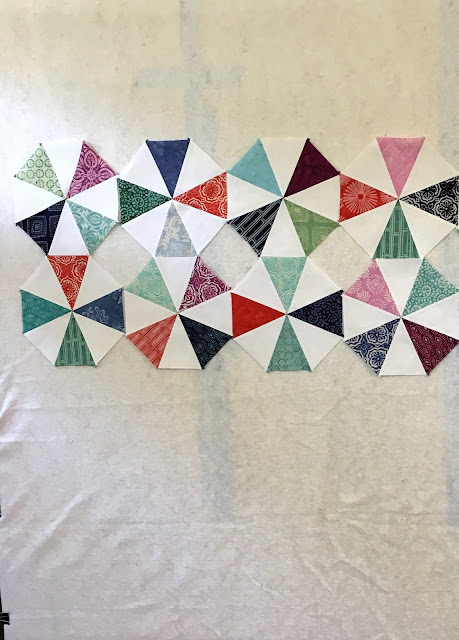Thanks for all the emails and questions about Kaleidoscope quilts. This post explains how to sew and position your fabric to make this beautiful Kate Spain. We will refer to this design as "The Batik".
My quilts have been so far made only using an AccuQuilt Go and their dies.
The good news is ... whether you cut your fabric with a die or by hand - the basic geometry and assembly of these quilts remains the same.
Let's begin: the fabric is Kate Spain's Latitude Batiks. Here is a link about batiks and needle and thread sizes if you are curious. I had success with just my usual #12 needles and Aurifil 50wt. thread.
Kaleidoscope quilts have two shapes - a larger Isosceles triangle and a smaller half square triangle.
The Isosceles triangle (the larger piece) is sewn to another isosceles triangle on a long side.
Press seams open and trim the dog ears at the tips.
With this style of Kaleidoscope quilt, now is a good time to make groups of 4 and balance the colors for each block.
Take your group of 4 units and lay them out as shown. Flip the pieces from the right side onto the left - right sides together. The arrows show where to pin and sew.
Line up the top and the side of your pieces accurately as shown above. Sew from that top right angle. This is the inside point of the Kaleidoscope block. When everything lines up nicely here - your points will match in the center of your finished product.
Press seams open. Take the two 'halves' and put them right sides together, pin and sew. Matching up that middle seam is the priority.
Press seams open. Make 42 blocks just like this with 4 focus fabric (batik)- and 4 background fabric (Kona white).
These are your basic units. Now it's time to do the layout.
This picture really shows you how to place your 8-sided 'wheels'. You can see that a batik triangle is always next to a white triangle. The flat portions of the 'wheel' are at the top and bottom. Those gaps between 'wheels' are where the little half triangles will go.
When a 'wheel' has a white center triangle --- it has white half square triangles in the corners. When a 'wheel' has a batik triangle in the center --- it has batik triangles in the corners. This is where taking a few pictures can really help to keep you on track.
Using the photos as a guide and only doing two rows at a time - I pinned all the white half square triangles where they needed to go before sewing. It was too easy to lose track, especially if you have interruptions or Netflix on :)
Put everything back on the design board and arrange the batik triangles. This is where you have a good deal of "Latitude" to balance color (couldn't resist the pun).
The last stage is trimming. I know that AccuQuilt prides itself on making accurate cuts with their dies so there is no need to trim. Even with starch and careful sewing I end up with wonky blocks as you can see from the picture above.
I sacrifice perfect points between blocks as I trim off the sides to 10.5" x 10.5".
In this finished picture of the quilt, the center points are really good - the ones on the sides not so much. I opt for consistent sized blocks versus design perfection!
So that's about it - the two blocks needed for this design of kaleidoscope quilt is shown above.
This layout pictures gives a bigger view of this design. I hope this takes the mystery out of what comprises a kaleidoscope quilt.
Lastly - my son works at a market and one of his co-workers had her wedding cancelled due to the virus. This quilt is for her. Kudos to the workers who help feed America everyday and those who keep us safe and healthy as well.
Latitude Batiks by Kate Spain / Moda
Kona white
Warm & White batting
Dimple dot minky in Azurite from Hawthorne Supply Co.
Aurifil Thread 50wt. #2600 (Dove for the front) and #2720 (Light Delft Blue) for the back
AccuQuilt dies: Triangle-Isosceles 5"x 6" / HST 3" Finished
Size: 60" x 70"
Date: May 2020




























